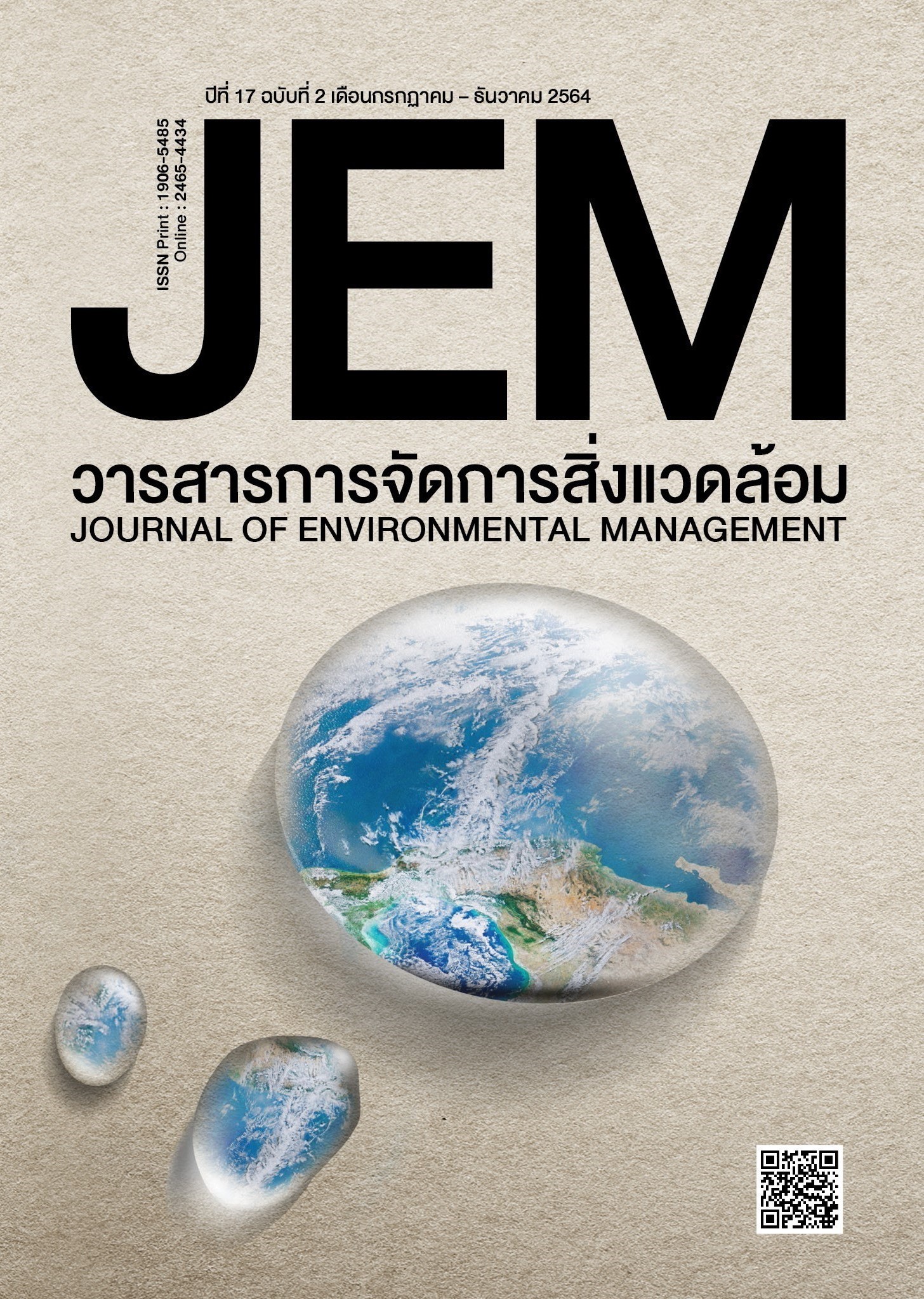การประเมินความเสี่ยงต่อสุขภาพจากการรับสัมผัสโลหะหนักปนเปื้อนในดิน ของผู้ประกอบการร้านรับซื้อและคัดแยกซากผลิตภัณฑ์เครื่องใช้ไฟฟ้าและอิเล็กทรอนิกส์ ในพื้นที่ตำบลแดงใหญ่ อำเภอบ้านใหม่ไชยพจน์ จังหวัดบุรีรัมย์
DOI:
https://doi.org/10.14456/jem.2021.11คำสำคัญ:
การประเมินความเสี่ยงต่อสุขภาพ, โลหะหนัก, ซากผลิตภัณฑ์เครื่องใช้ไฟฟ้าและอิเล็กทรอนิกส์บทคัดย่อ
งานวิจัยนี้เป็นการประเมินความเสี่ยงต่อสุขภาพจากการรับสัมผัสโลหะหนักปนเปื้อนในดินของผู้ประกอบการร้านรับซื้อและคัดแยกซากผลิตภัณฑ์เครื่องใช้ไฟฟ้าและอิเล็กทรอนิกส์ในพื้นที่ตำบลแดงใหญ่ อำเภอบ้านใหม่ไชยพจน์ จังหวัดบุรีรัมย์ เก็บตัวอย่างดินด้วยวิธีการ Judgment/Biased Sampling บริเวณร้านรับซื้อและคัดแยก 77 แห่ง วิเคราะห์ปริมาณโลหะหนักด้วยเทคนิค X-ray Fluorescence Spectrophotometry (XRF) และเทคนิค Atomic Absorption Spectrophotometry (AAS) ผลการศึกษาพบว่า การวิเคราะห์ความแตกต่างทางสถิติ Independent Samples Test (t-test) ของปริมาณโลหะหนักปนเปื้อนในดินทั้งสองวิธีการ พบว่า ปริมาณทองแดง ตะกั่ว สังกะสีไม่มีความแตกต่างกันที่ระดับนัยสำคัญทางสถิติ 0.05 และปริมาณแคดเมียม นิกเกิล แมงกานีส โครเมียม แตกต่างกันที่ระดับนัยสำคัญทางสถิติ 0.05 ทั้งนี้ สารหนูไม่สามารถวิเคราะห์ความแตกต่างได้เนื่องจากตรวจไม่พบ ผลการประเมินความเสี่ยงการรับสัมผัสของการปนเปื้อนโลหะหนักจากการคัดแยกทั้งสองวิธีการ พบว่า ไม่มีความเสี่ยงต่อการรับสัมผัสที่มีอันตรายต่อสุขภาพ อย่างไรก็ตามถึงแม้ผลการประเมินความเสี่ยงต่อการรับสัมผัสของผู้ประกอบการร้านรับซื้อและคัดแยก อยู่ในระดับที่ไม่เป็นอันตรายต่อสุขภาพ ผู้ประกอบการรับซื้อและคัดแยก ควรมีการเฝ้าระวังและป้องกันอันตรายส่วนบุคคลขณะปฏิบัติงาน และองค์การบริหารส่วนตำบลตำบลแดงใหญ่ ควรเข้าไปดูแลการดำเนินงานให้ข้อแนะนำในการรับซื้อและการจัดการที่ถูกต้องอย่างสม่ำเสมอ
เอกสารอ้างอิง
Announcement of the National Environment Committee issue 25 (2004). soil quality standards. the government gazette, 121(119), 170 - 181.
Pollution Control Department. (2020). heavy metal contaminated in soil of operators who work at waste electrical and electronic equipment sorting and retail shops located in Ban Daeng Yai, BanMai Chaiyaphot District, Buriram Provincn. report. Bangkok: Pollution Control Department.
Pollution Control Department. (2020). Report of the situation of hazardous waste from the community 2019. Bangkok: Pollution Control Department.
Pollution Control Department. (2012). Guidelines for the Evaluation of waste from electrical and electronic equipments assessment project. Bangkok :Pollution Control Department.
Department of Industrial Works. (2016). Guide to Survey and Inspection of Contamination in Soil and Ground Water from Industrial Works. Bangkok: Department of Industrial Works.
Konjanawan, K., Satrabhan, N., Khunchalee, K., & Prueksasit, T. (2020). Health Risk Assessment of Electronic Waste Dismantling Workers Exposed to Heavy Metals via Dermal Absorption in Burirum Province. Journal of Safety and Health, 13(2), 18 – 31.
Saetang, P., Rojanpraiwong, S., Mooksuwan, W., & Pratumchat S., (2009). A preliminary workshop to study the impact and seek a participatory waste management approach In the case of Khok Sa-at Subdistrict, Khong Chai district, Kalasin Province. Ecological Alert and Recovery-Thailand. The Asia Foundation (Thailand).
Charusiri, W. (2018). Hazardous and Industrial Waste Management. Bangkok: Uptoyou service company limited.
Ministry of VRIOM. (2013). Soil Remediation Circular 2013. Ministry of Housing, Spatial Planning and the Environment (Netherlands). Retrieved January 10, 2021, form https://esdat.net.
Blackman, W.C. Jr. (2001). Basic Hazardous Waste Management, 3rd ed. CRC Press.
LaGrega M.D., Buckingham P.L. and Evans J.C. (2001). Hazardous Waste Management. 2nd ed. McGraw-Hill.
Roberts, S.M. and Teaf, C.M. (1998). Hazardous Waste Incineration: Evaluating the Human Health and Environmental Risks. CRC Press.
Sullivan, J.B. and Kreiger, G.R. (1992). Hazardous Materials Technology: Clinica; Principles of Environmental Health. Willium & Wilkins.
A. Petroczi, D. P. Naughton (2009). Mercury, cadmium and lead contamination in seafood: A comparative study to evaluate the usefulness of Target Hazard Quotients. Food and Chemical Toxicology, 47(2), 298-302.
N. Bortey-Sam, S.-M.M. Nakayama, Y. Ikenaka, O. Akoto, E. Baidoo, Y.B., Yohannes, H. Mizukawa, M. Ishizukaa. (2015). Ecotoxicology and Environmental Safety 111, 160-167.
A.J. Gutiérrez, C. Rubio, I.M. Moreno, A.G. González, D. Gonzalez-Weller, N. Bencharki, A. Hardisson, C. Reverte. (2017). Estimation of dietary intake and target hazard quotients for metals by consumption of wines from the Canary Islands. Food and Chemical Toxicology, 108, 10-18.



